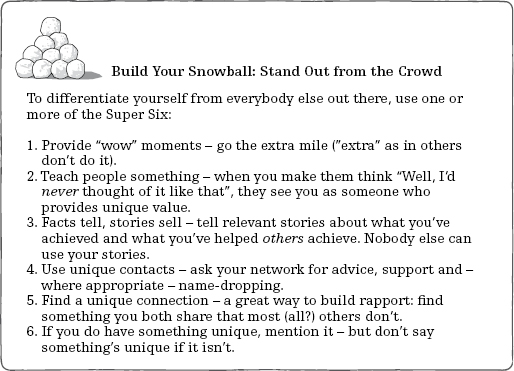22
When you want to stand out from the crowd
The previous two chapters looked at how to make more sales, including how to improve your sales communications.
Another key component of selling anything – yourself, your ideas, your proposals – is that you stand out from the crowd.
After all, to convince someone to choose you, you must appear different to their alternatives. If you’re not, you won’t “win”.
Here are six approaches to help you do this really well. One of my customers christened these the Super Six.
Method #1: Provide “wow” moments
People want amazing experiences that they remember for years. So, go the extra mile to provide them with “wow” moments.
I use the phrase “extra mile” deliberately. Most people think they do this. They don’t, or it wouldn’t be called “extra”. It’d be “the mile that everyone always goes”.
So, go extra miles to give an extra wow:
- To your customers – deliver jaw-dropping service and provide amazing add-ons they weren’t expecting.
- To your colleagues – get to know them as people, fuel their passion, publicly recognize them, make your meetings/presentations exciting.
- To your boss – work hard to make yourself a pleasure to be with, provide value and insights nobody else does, make them look good, volunteer for things, come in early, stay late.
Method #2: Teach them something
If you can get someone to think “Well, I’d never thought of it like that”, it’s a great start. It ticks both boxes of you being (a) different and (b) value-adding. Nobody else has made them think this, or it wouldn’t have been new to them.
For example, a couple of years ago I was asked to visit a large retail organization, to help improve their employee engagement. Before I went, I asked around, and found someone who used to work there. I asked her what she thought of the engagement and the reasons for it. She told me, then introduced me to some of her ex-colleagues, who were also very honest. These conversations led me to uncover that:
- The bosses didn’t communicate with their people.
- This meant there wasn’t enough information flowing around the organization.
- This led to people thinking “information is power”.
- Which caused them not to share information they heard.
- This meant all the usual flows of information – vertical through the hierarchy, horizontal across departments – just wasn’t happening.
- All of which was the main cause of low employee engagement.
When I met the Exec for the first time, I was able to share what I’d found out, and asked if they thought this was a fair reflection of the way things were. It turned out it was. And it also turned out they hadn’t thought of it like that, and were delighted I’d told them. Nobody else had done.
Method #3: Facts tell, stories sell
Relaying a story about something you’ve achieved, and the impact it had, differentiates you. After all, nobody else can say they’ve done it, because you’re the only one who did.
Most importantly, ensure you link your story to the needs of the person you’re seeking to impress. This helps them perceive you as uniquely placed to help them, rather than you simply discussing your own genius.
For example: “You mentioned at last week’s conference that you want us to be more customer-focused. I’d like to volunteer to help with this. I was part of a team that ran a similar project at my previous company, which led to market share increasing by X% in only Y months.”
Also, when choosing your best stories, remember that people often want to see you can have a long-term impact (the next chapter shows how to do this), so focus more on these examples than your short-term successes.
Method #4: Use unique contacts
If you know someone who knows the person you want to impress, ask:
- Their advice on how to approach them.
- Their permission to mention their name in your meeting.
- How they want you to mention them. For example, do they want you just to say their name, or describe something they’ve done? Doing this ensures your interaction benefits all three of you, and almost always leads to quicker rapport-building in your meeting.
Method #5: Find a unique connection
Finding common ground accelerates the rapport-build. And it will set you apart if you’re the only one who made the connection. But, beware:
- Ensure it’s a real connection, not one you’ve assumed to be true.
- Make sure you ask them about their thoughts on your shared interest. Don’t use common ground as an excuse for you to give your opinions only.
- Forced, shallow connections don’t work. Once, a door-to-door salesman saw my daughter’s bike outside our house. Then, when I opened the door, he blurted out “I’ve got children too”, which was a little perturbing.
The last point is important. A lot of us are told to build rapport, but don’t be too “friendly” too soon. Tony Birch – a proposal expert at Shipley Ltd. (if you write proposals, look them up: a great company) – told me of a procurement director who hated salespeople’s phony rapport-building so much that he put a photograph of some children on his desk. Then, every time a salesperson spotted the photograph and said “Are they your children?”, he replied “No. What do you want?”
Method #6: If you do have something unique, mention it
The last of the Super Six is to mention something unique, if you have it. This can be very powerful, but ensure that:
- Your unique thing relates to their agenda, or is fascinating enough on its own so that they want to hear more.
- It is unique: “I’ve led big teams before” isn’t. Neither is “We have exceptional customer service”. Everyone says this.
- You stop discussing it if they don’t seem interested.
Also, be careful when discussing your unique thing. People might not be impressed by it. For instance, a taxi driver once told me he stayed in a bed and breakfast in Blackpool which had a unique thing: no cold water. When he asked what to do if he wanted some, the owner replied “Just run a bowl of hot water, and wait for a bit”. That made that B&B unique, but certainly not of benefit to . . . well, anyone.
Which of the Super Six is Best?
It depends. But use at least one. If you don’t, you look the same as everyone else, and you’re soon going to hear “So, why are you better than my alternatives?” or, more depressingly, “Can you do anything about the price?”

